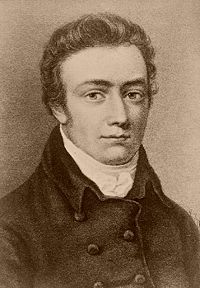|
|
| Line 1: |
Line 1: |
| {{:Poetry/Tabs}} | | {{:Poetry/Tabs}} |
| {{see also|Romanticism: Revolt of the Spirit}} | | {{see also|Romanticism: Revolt of the Spirit}} |
| Romanticism refers to the poetry of the Romantic era, which emerged in the late 18th century and lasted until the mid-19th century.
| | {{dc|R}}{{start|omanticism refers to the poetry of the Romantic era}}, which emerged in the late 18th century and lasted until the mid-19th century. |
|
| |
|
| {{Collapse top|title=General Characteristics|bg=#F0F2F5|left=yes}} | | {{Collapse top|title=General Characteristics|bg=#F0F2F5|left=yes}} |
Revision as of 10:16, 18 February 2023
Romanticism refers to the poetry of the Romantic era, which emerged in the late 18th century and lasted until the mid-19th century.
General Characteristics
|
|
Some general characteristics of Romantic poetry include:
- Emphasis on emotion and imagination: Romantic poets placed a strong emphasis on emotion and the imagination, often valuing these over reason and logic.
- Love of nature: Many Romantic poets celebrated the beauty and power of nature, often using it as a source of inspiration or a symbol of the divine.
- Interest in the supernatural and the mysterious: Romantic poets were fascinated by the supernatural and the mysterious, often exploring these themes in their work.
- Individualism and personal experience: Romantic poets often focused on the individual experience rather than the collective or universal, often drawing on their own personal experiences and emotions.
- Celebration of the common people: Many Romantic poets celebrated the lives and struggles of ordinary people, often highlighting the injustices and inequalities of their time.
- Use of symbolism and metaphor: Romantic poets often used symbolic and metaphorical language to represent complex ideas or emotions.
- Experimentation with form and language: Romantic poets often experimented with new forms of poetry, such as the lyric, the ballad, and free verse, and often used unconventional language and syntax to create new effects.
These characteristics are not exhaustive, and there is considerable variety within Romantic poetry. However, they provide a general sense of the key features of the genre.
|

| William Blake
|
| From Songs of Innocence:
|
From Songs of Experience:
|
|
|
| Elizabeth Barrett Browning
|
|
|
|
| George Gordon, Lord Byron
|
|
|
|
|
| Mary Elizabeth Coleridge
|
|
|
|
| Samuel Taylor Coleridge
|
|
|
|
|
| Emily Dickinson
|
|
|
|
| John Keats
|
|
|
|
|
| Edgar Allan Poe
|
|
|
|
|
| Percy Bysshe Shelley
|
|
|
|
|
| William Wordsworth
|
|
|
|
|






